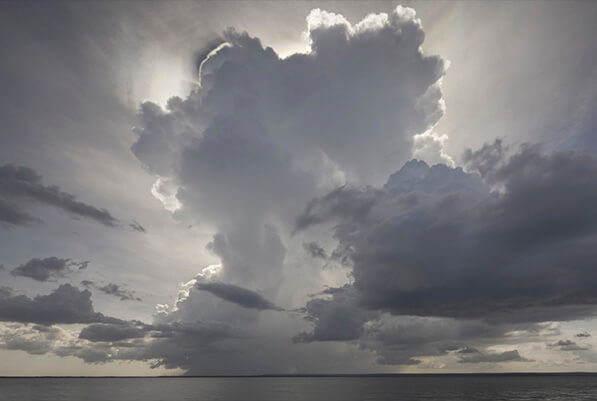
'Hector' or 'Hector the Convector' is the world's largest thunderstorm that forms daily over the Tiwi Islands during the build-up to the Monsoon each year.
Originally located and shot for an exhibition series, Murray Fredericks was briefed to capture time-lapse footage of Hector in all its manifestations for Our Planet (David Attenborough / Netflix / Silverback), Our Perfect Planet (David Attenborough / BBC) and Wonders of the Monsoon (BBC).
As the Tiwi Islands are mostly flat and tree covered, vantage points to capture such an epic subject are rare. Fredericks established a jungle camp in a location with panoramic views of Hector. He remained there for weeks at a time, perfectly placed to capture the storms during daytime, at night and through light transitions.
First Footprints Timelapse Reel.
First Footprints is the history of the first settlement of Australia by humans over 50.000 years ago. It is told through interviews with elders, archaeologists and the stories conveyed in rock art.
The time-lapse brief on this series was to record the rock art and the incredible landscapes it sits within. The rock art was far more visible to the camera at night, when lit by moonlight against a black or star filled sky. Fredericks spent many nights over a period of two years, camped in caves with cameras rolling on motion control rigs.
The shoot was complex and within the small team that created the series, Fredericks worked mostly alone on the time-lapse footage, setting up the camblock system for pan, tilt and dolly, all coordinated with the rising and setting of the moon and transitions from night to day.
"Over 50,000 years of Australia's ancient past is brought to life through the world's oldest oral stories, new archaeological discoveries, stunning art, cinematic CGI and never before seen archival film"
As the Tiwi Islands are mostly flat and tree covered, vantage points to capture such an epic subject are rare. Fredericks established a jungle camp in a location with panoramic views of Hector. He remained there for weeks at a time, perfectly placed to capture the storms during daytime, at night and through light transitions.
The production 'One Strange Rock' by National Geographic coveys the extraordinary story of Earth and why it is special and uniquely brimming with life among a largely unknown but harsh cosmic arena; astronauts tell the story of Earth through a unique perspective.
The Time-lapse brief specifically required capturing the Milky Way rising and setting over Uluru, along with moon/rise and set and transitions from day to night. Star charts were used to plan the shoot prior to arriving.
Most of the shoot was captured using static DSLR setups with some tilt and pan motion control perfromed using the Camblock system.
Murray Fredericks worked with the BBC team to capture time-lapse footage of storms across the Tiwi Islands, Northern Territory and the top of Western Australia. Thousands of kilometres were covered by the team, chasing violent storms during the build-up to the monsoon.